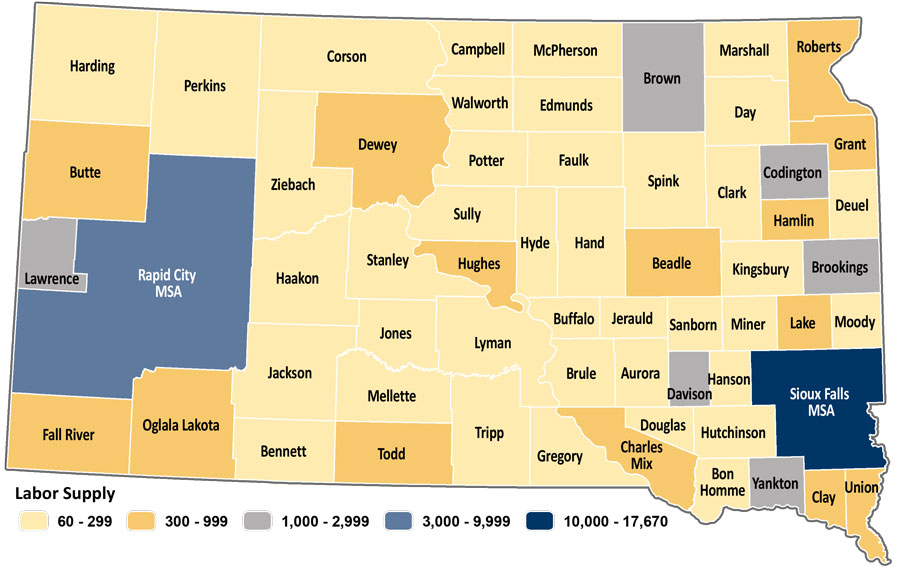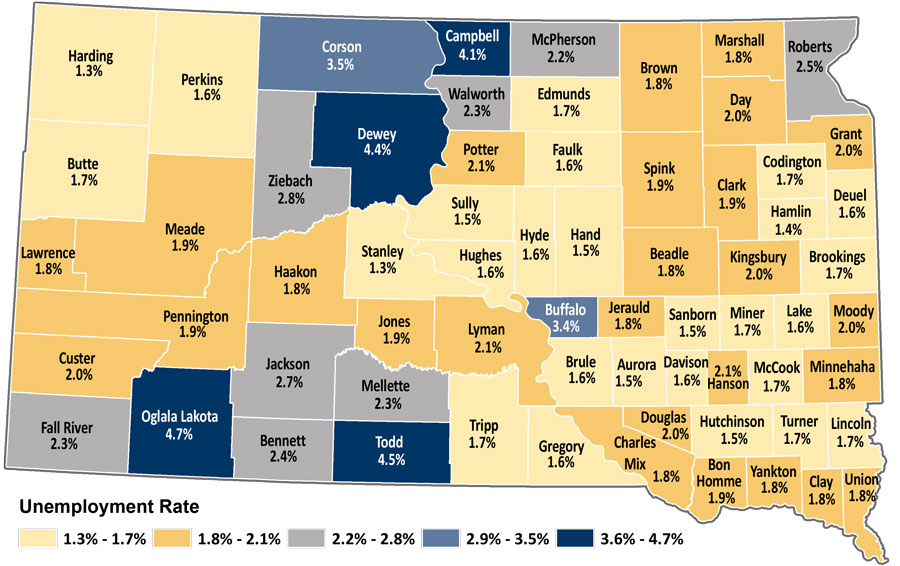- Home to LMIC
- Virtual Labor Market Data System
- Career Exploration & Planning
- Consumer Price Index
- Demographics
- Economic Snapshot
- Employee Benefits
- Employment Projections
- Labor Force & Unemployment
- Labor Supply
- Overview of the Current Labor Market
- Surveys We Conduct
- Wages & Income
- Workers by Industry
- Tools & Resources
- Publications
- References
- What's New
- Can't Find It?
Labor Market Information Center
Overview of the Labor Market
The overview below is based on South Dakota data for September 2025, the most recent data available. The data for September 2025 were originally scheduled to be released October 17 but were delayed due to the suspension of federal government services, including the U.S. Bureau of Labor Statistics (BLS).
Labor Supply
The number of South Dakotans who would be available to staff a new or expanding business, or South Dakota's labor supply, was estimated at 50,830 in September 2025. Included in this labor supply are those who currently hold jobs (and would like to change) and those who, for a variety of reasons, do not have jobs.
South Dakota Labor Supply
September 2025

Labor Force
This data is seasonally adjusted.
Preliminary estimates show South Dakota's unemployment rate increased 0.1% to 2.0% in September 2025. The labor force decreased over the month by 300 workers (0.1%) to 492,400 workers. The level of unemployed increased by 300 (3.2%) to 9,700 persons unemployed.
South Dakota's September 2025 labor force of 492,400 increased compared to the September 2024 level of 490,500. The level of employed increased by 1,300 (0.3%); the number of unemployed increased by 600 persons (6.6%). The unemployment rate increased 0.2% to 2.0%.
South Dakota Unemployment Rates by County
September 2025
This data is not seasonally adjusted.

Notes about labor force data
The unemployment rate represents the number of unemployed as a percent of the labor force. People are classified as unemployed if they do not have jobs, have actively looked for work in the prior four weeks and are currently available for work. People who were not working and were waiting to be recalled to jobs from which they were temporarily laid off are also included as unemployed.
Labor force estimates for South Dakota are produced by the Labor Market Information Center in cooperation with the U.S. Bureau of Labor Statistics. The concepts and definitions underlying the labor force data come from the Current Population Survey (CPS), the household survey which is the official measure of the labor force for the nation. The statewide estimate of the number of nonfarm jobs is a component of the model used to produce the labor force estimates. Other data used in this model include the number of continued unemployment insurance claims and survey data from the Current Population Survey (CPS) which is specific to the state.
Although state specific data is used in the production of the labor force estimates for South Dakota, the state monthly model estimates are controlled in "real time" to sum to national monthly labor force estimates from the CPS. Therefore, variation in the estimates of the employed and unemployed are somewhat controlled by what is happening nationally.
South Dakota Nonfarm Wage & Salaried Workers by Industry
This data is not seasonally adjusted.
Over-the-month comparisons
Based on a monthly survey of South Dakota establishments, preliminary estimates show the total nonfarm wage and salaried worker level increased by 300 (0.1%) from August 2025 to September 2025.
Leisure and Hospitality declined 7.8% with a loss of 4,300 workers. This supersector went from 55,400 workers in August 2025 to 51,100 workers in September 2025. Losses were spread throughout the state. While the Rapid City Metropolitan Statistical Area (MSA) had a loss of 1,500 workers (11.5%) over the month, the Sioux Falls MSA declined 900 (5.0%). This seasonal loss is expected as establishments in visitor destinations reduce staff in response to a drop in visitors. Establishments included in this supersector are restaurants, campgrounds, hotels, water parks, and golf courses.
Retail Trade showed a loss of 600 workers (1.1%) over the month. Declines in September are common and can be associated with a drop in part-time workers as many high school and college students transition from work back to school. Clothing stores, web retailers, home furnishing stores, hardware stores, supermarkets, gasoline stations, antique shops, and souvenir stores are just a few examples of establishments in this sector
Private Education and Health Services gained 1,600 workers (2.0%) over the month. Private Educational Services accounted for this growth, adding 1,700 workers (30.4%). Gains in Private Educational Services are common this time of year as many establishments add to their workforce for the new school year. Health Care and Social Assistance had a minor loss of 100 workers over the month, typical for this time of year and spread throughout many of the establishments within this sector. Establishments in Health Care and Social Assistance include dentist offices, chiropractors, childcare centers, assisted living facilities, and vocational rehabilitation agencies. Hospitals showed a small gain of 100 workers (0.3%).
Government worker levels increased 5,400 (6.8%) in September 2025. Local Government and State Government accounted for this growth, adding 3,200 (6.5%) and 2,200 (12.4%), respectively. Many of the gains within Local and State Government were due to increases in Educational Services as schools ramped up staffing for a new school year. Federal Government remained unchanged in September with 11,500 workers.
Over-the-year comparisons
The total nonfarm wage and salaried worker level increased by 4,100 workers (0.9%) from September 2024 to September 2025. The top contributors to this growth were Construction; Professional & Business Services; and Government.
Construction worker levels continued to trend up, adding 1,400 (4.5%) over the year. Specialty Trade Contractor accounted for half of this growth with the addition of 700 workers (3.9%). Specialty Trade Contractors perform a specific activity, such as site preparation, pouring concrete, plumbing, painting, and electrical work. Heavy and Civil Engineering worker levels rose 200 (3.8%) over the year, and Constructions of Buildings increased 500 (6.6%). Growth in construction is driven by increased demand for housing and new commercial projects that come with population growth. Apartment complexes, strip malls, home renovations, and road improvements are just a few examples of projects underway throughout the state.
Professional & Business Services added 1,700 workers (4.5%). Most of this growth took place outside the Sioux Falls and Rapid City metro areas. The Sioux Falls and Rapid City MSAs gained 500 workers. The statewide total worker level in Professional & Business Services was 39,200.
Manufacturing had a loss of 900 workers (2.0%) from September 2024 to September 2025. The majority of these losses took place outside the Sioux Falls and Rapid City MSAs. Non-Durable Goods Manufacturing accounted for most of the loss, dropping 600 (3.5%) over the year. Non-Durable Goods include food and beverage products, paper products, and fuel. Durable Goods Manufacturing showed a minor loss of 300 workers over the year, declining to 27,400 workers in September 2025. Examples of durable goods include trailers, furniture, and electronic equipment.
Financial Activities recorded a slight gain of 400 workers (1.5%) over the year. The gain was in the non-metro areas, with the Sioux Falls MSA displaying a decrease of 400 workers (2.7%), and the Rapid City MSA remaining unchanged with 3,600 workers.
Government had a gain of 1,200 workers (1.4%) overall from September of 2024. Local Government added 700 workers (1.3%), reaching 52,800 workers in September 2025. Local Government Educational Services gained 200 workers (0.7%). State Government added 800 workers (4.2%) as the school year was ramping up in August and September. As the population rises, city programs and services also grow to meet the needs of the community. Meanwhile, Federal Government showed a decline of 300 workers (2.5%) over the year.
